Notes on Bogotá vs Curitiba
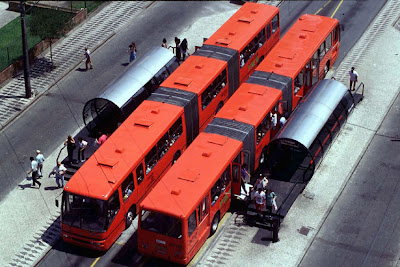
Curitiba, Brazil
Bogotá is interesting and important for many reasons but I write only to draw some quick comparisons between it and the Latin American success story probably best known by U.S. planners: Curitiba, Brazil. We mostly know Curitiba for its visionary mayor, Jaime Lerner, who made as much progress as anyone in a metropolitan city in promoting transit over car use for commuting, among several other impressive accomplishments. (PBS even has a web site on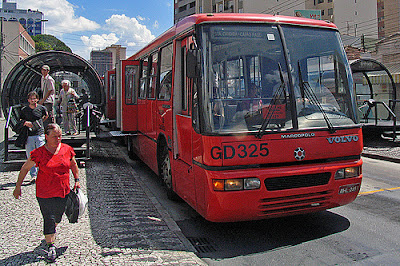 the city’s planning history.) Lerner went on to become a multi-term mayor and then governor of that state — and an international spokesperson for rational, economical, “smart” urban development — and has even longer led a planning/architecture firm that remains extremely influential in Curitiba development and policy circles.
the city’s planning history.) Lerner went on to become a multi-term mayor and then governor of that state — and an international spokesperson for rational, economical, “smart” urban development — and has even longer led a planning/architecture firm that remains extremely influential in Curitiba development and policy circles.
The New York Times Sunday Magazine published a provocative May 20 piece on Curitiba. (This is available online for the right price, or you can read it without the pictures in Matt Kahn’s blog here.) It emphasized two points made in recent years: That Lerner’s initial great successes were due in no small part to the existence of a military dictatorship at the national level at the time, and that many positive planning indicators have begun to slip lately, especially in the face of a growing low-income population at the urban periphery. Even the transit mode share is dropping.
Meanwhile, I visited Bogotá for the first time last week for a Lincoln seminar (all presentations are here) and, in addition to soaking up what I could of the urban colonial milieu in el centro, met Arturo Ardila-Gómez, a professor at the University of the Andes. His MIT urban studies dissertation, supervised by Ralph Gakenheimer, compared the transit planning processes of Bogotá and Curitiba during many of their formative transit years. He summarized his argument and evidence, as best I remember, as disputing the first part of the NYT article; namely, Lerner was effective mainly because he was a coalition builder, even when the system was not particularly democratic. Another point made in this presentation is that both bus systems were successful, in various respects, because they managed to balance the authority and expertise of both the transit operators and the municipal government. (He also has a nice essay on Bogotá, mostly from a planner’s perspective, here in the Harvard Review of Latin America, circa 2003.)
I do not really know much about either city, or country, and hope the accidental reader can offer useful comparative information.
Bogotá, Colombia
A densely sprawling city of 7 million plus, I can tell you that Bogotá is substantially safer and more pleasant than I imagined, owing apparently to a series of quite visionary and effective mayors over the past decade and a half. And the country is far more compelling than the casual observer might guess: The ambassador to the U.S. Carolina Barco is a city planner (MCP, Harvard; SPURS, MIT) and the foreign minister Fernando Araujo was appointed to that position in February, just 7 weeks after escaping from the leftist FARC (Revolutionary Armed Forces of Colombia) rebels, active in Colombia for 40 something years, after being held prisoner in the rain forest the previous 6 years. If you happened to catch him on Charlie Rose two months ago, available here, it was quite a tale. Then there is the extraordinary rising star of 34 year old Senator Gina Parody, the sponsor of our meeting in the National Congress. (Significantly, the president of the Colombian congress is also female.)
years. If you happened to catch him on Charlie Rose two months ago, available here, it was quite a tale. Then there is the extraordinary rising star of 34 year old Senator Gina Parody, the sponsor of our meeting in the National Congress. (Significantly, the president of the Colombian congress is also female.)
President Uribe, another controversial yet extremely popular center-right figure — snubbed recently by Al Gore due to rumored past connections with right wing paramilitary groups, and who has the additional baggage of a good relationship with our President Bush (in return for $700+ million/year in U.S. aid, that we know of) — is pushing for a NAFTA-like Latin American free trade agreement while prioritizing a domestic crack down on rebel violence. (The Washington Post has audio interviews from his recent visit to D.C., where his lobbying to the new Democratic leadership in Congress was widely reported as having received little sympathy.)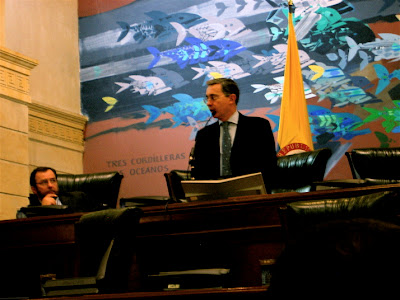
That said, a highlight of the trip for me was when Uribe spoke to our seminar and took questions in the National Congress building. A former mayor and governor, he impressed even political opponents with his detailed knowledge of municipal finance and land taxation policy wrinkles, and his openness to debate on these issues. Since lots of heavily armed people would like him dead, security was high. (His father was assassinated by the FARC in 1983 and he has survived several such attempts.)
I also enjoyed meeting two past mayors, one now running for reelection: the bold, innovative, and engaging Enrique Peñalosa, largely responsible for the successful Curitiba-like bus rapid transit, the TransMilenio. As Mexico still does, Colombia only permitted mayors to serve one 3-year term in a row until recently. This is crazy, especially for planning purposes, but at least Colombian mayoral terms have recently been extended to 4 years. Allowing a second consecutive term seems wise. (And the Colombian president can now serve two 4-year terms; Uribe is the first two-term president in the country’s modern history, with approval ratings in the 60s and 70s.)
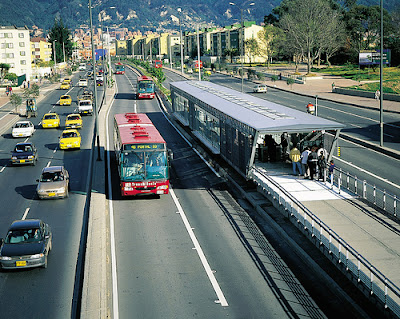
(I was introduced to Professor Ardila by my former student, Professor Eduardo Behrentz, an air quality expert now directing the Environmental Engineering Research Center at the University of the Andes. 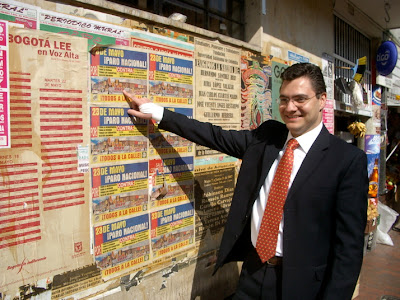 This photo has him pointing to an announcement of that day’s march protesting the pending trade agreement. Like many Colombian academics, he actively advises the government and writes op-eds, such as on the issue of the exhaust of the diesel TransMilenio buses. It is quite unhealthy as diesel particulates are bad enough, but Colombian diesel is particularly high sulfur. Efforts to change this at the refinery stage have sputtered. He advised importing cleaner diesel until better domestic supplies are refined.)
This photo has him pointing to an announcement of that day’s march protesting the pending trade agreement. Like many Colombian academics, he actively advises the government and writes op-eds, such as on the issue of the exhaust of the diesel TransMilenio buses. It is quite unhealthy as diesel particulates are bad enough, but Colombian diesel is particularly high sulfur. Efforts to change this at the refinery stage have sputtered. He advised importing cleaner diesel until better domestic supplies are refined.)
Every Colombian politician I’ve mentioned here is astoundingly well informed, a lot smarter than most smart people I know, and — as influential pivots in contentious, risky settings — somewhat polarizing. Their attention to fundamental planning issues and interest in the related scholarship is especially refreshing. I dearly hope to learn more about these cities, their planning processes, their results, and not least their lessons for elsewhere.
- Published:
- Thursday, May 31st, 2007
- Author:
- randall Crane
- Topics:
- BRT, Latin America, politics, TOD, trips
Blogroll
- Becker-Posner blog
- BLDG BLOG
- Burb
- CityStates
- Curbed LA
- Cyburbia
- DemocraticSPACE
- Environmental and Urban Economics
- Freakonomics
- LA Transportation Headlines
- Peter Gordon’s Blog
- Planetizen
- The Center for Land Use Interpretation
- The Transportationist
- the urban commons
- This week’s finds in planning
- Urbanicity
Journals
- Cityscape
- environment and planning a,b,c,d
- Harvard Design Magazine
- Housing Policy Debate
- Housing Studies
- International Development Planning Review
- International Journal of Urban and Regional Research
- International Regional Science Review
- Journal of Architectural and Planning Research
- Journal of Housing Economics
- Journal of Planning Education and Research
- Journal of Planning Literature
- Journal of Regional Science
- Journal of the American Planning Association
- Journal of Urban Affairs
- Journal of Urban Economics
- Planning Theory
- Regional Science & Urban Economics
- Transportation Research Parts A,B,C,D,E,F
- Urban Studies
- World Development

Comments are closed
Comments are currently closed on this entry.